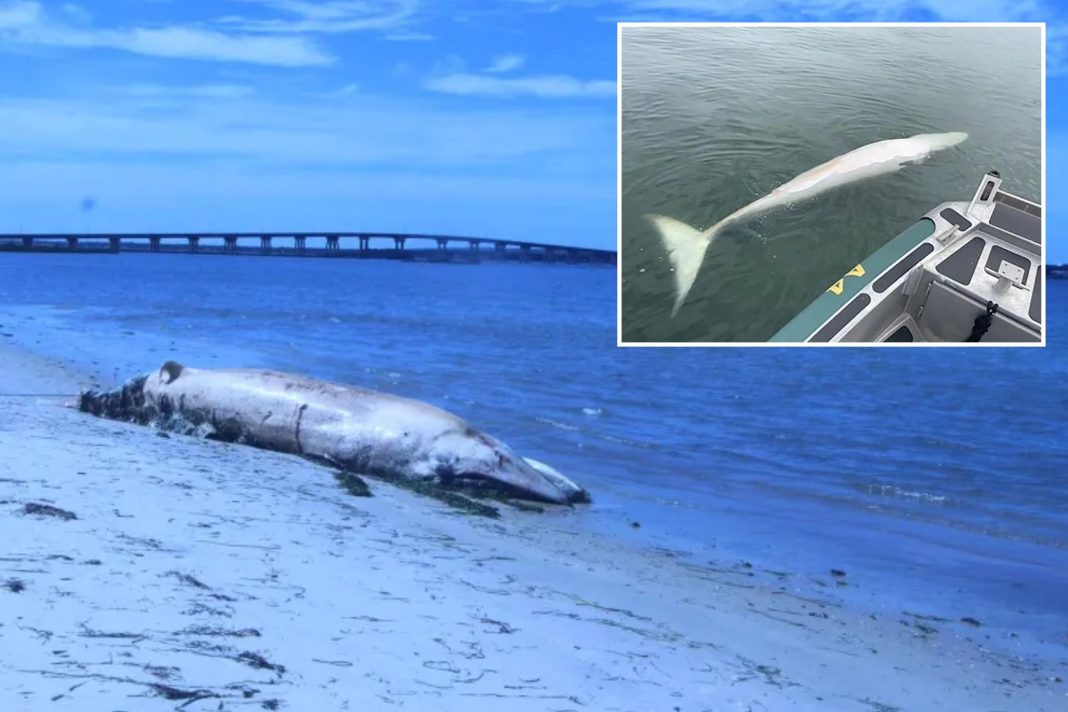In recent weeks, the coastal waters of New Jersey have been the focus of unsettling marine biology news, as the remains of a young minke whale washed ashore, just one day after another dead whale was spotted floating near Staten Island. This sequence of events has raised alarm among marine biologists and conservationists, prompting an urgent examination into the health of marine ecosystems along the Atlantic coast.
On Thursday, the U.S. Coast Guard discovered a 16- to 18-foot-long whale adrift in the Lower Bay/Raritan Bay area. In a bid to track the whale’s movements, a tracking tag was affixed to its carcass. Federal investigators from the National Oceanic and Atmospheric Administration (NOAA) anticipate that the whale will eventually wash ashore near Sandy Hook, New Jersey, where it will undergo a thorough examination. Observations like these are becoming increasingly common; the health of marine mammals is in jeopardy, and the implications extend beyond individual animals to the broader marine environment.
Less than 24 hours later, at approximately 6:30 a.m. on Friday, a smaller minke whale, measuring between 10 and 12 feet, washed up near Trenton Avenue in Lavallette, NJ. The Marine Mammal Stranding Center in Brigantine reported that this young whale would be transported to a public works yard for necropsy, a critical step in understanding the causes of its untimely demise.
The minke whale, known as the smallest of the baleen whale species, has been at the center of a troubling trend. Since 2017, NOAA has been investigating “unusual mortality events” (UMEs) involving these whales, a classification that encompasses unexpected strandings, significant die-offs, and situations demanding immediate response. This initiative was sparked by a disturbing spike in whale deaths along the Atlantic coast, with 27 whales found dead in 2017 alone.
Since the launch of this investigation, the reports have not improved. In New York waters, 26 minke whale deaths have been documented, while New Jersey has seen 14. The year 2024 has already recorded eight whale strandings in these two states, highlighting an alarming trend that demands attention. Andrea Gomez, a NOAA spokeswoman, noted the seriousness of the situation, stating, “We don’t know yet if something is happening in the Atlantic that is causing all of these UMEs for different species, which is why the work of our stranding networks and researchers is so important.”
This ambiguity surrounding the cause of these mortality events raises questions for both scientists and the public. What factors contribute to the stranding and death of these marine mammals? Is it pollution, climate change, changes in prey availability, or perhaps ship strikes? Recent studies have shown that various stressors, including increased vessel traffic and habitat degradation, could be contributing to these unfortunate events.
As we grapple with the reality of dwindling whale populations, it becomes essential to support ongoing research and conservation efforts. The health of our oceans is intricately linked to the well-being of these majestic creatures. By understanding the factors leading to unusual mortality events, we can take proactive measures to protect not only minke whales but also the entire marine ecosystem.
In conclusion, the recent strandings of minke whales in New Jersey and New York serve as a stark reminder of the fragility of marine life. As investigations continue, raising awareness about these issues and supporting marine conservation efforts will be crucial in ensuring the survival of these remarkable species. The fate of the minke whale may well reflect the overall health of our oceans, and it is imperative that we heed the warning signs before it’s too late.

